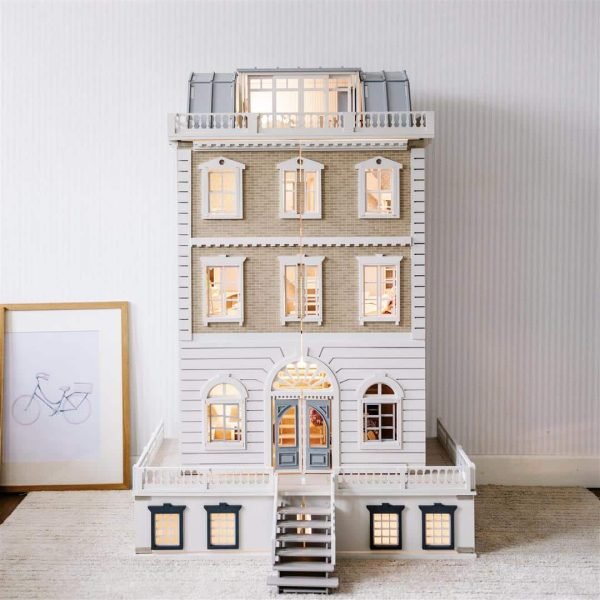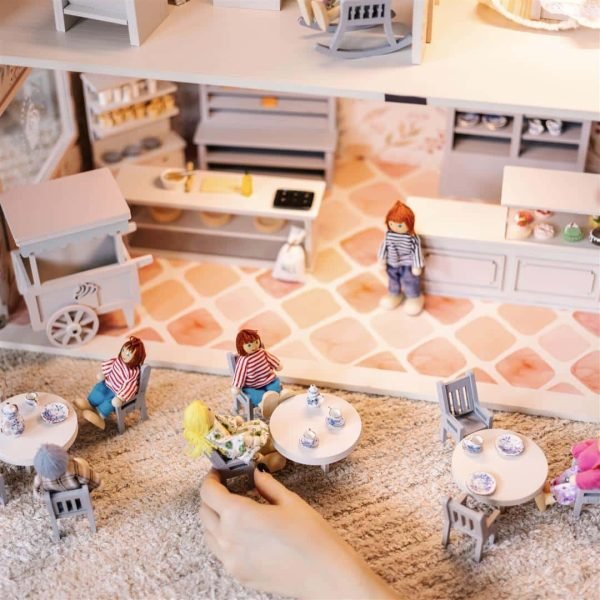Wooden vs. Plastic Dollhouses: Which One Is Better for Your Child?
Parents today face a multitude of decisions when selecting toys for their children, especially when it comes to choosing a dollhouse. Should you opt for a wooden dollhouse known for its durability and sustainability, or a plastic dollhouse, often lauded for its affordability and colorful design? This article breaks down the differences between these two popular choices, helping you decide which is best for your family.
Why Wooden Dollhouses Stand Out
Durability and Timeless Appeal
Wooden dollhouses are known for their durability and ability to withstand years of play. Many wooden toys, including those from Little Forest Animals, are designed to last generations, making them a smart investment for families. Wooden dollhouses not only hold up better against wear and tear but also retain their aesthetic charm over time. Their classic and often minimalist designs, such as the House of London Dollhouse, evoke a sense of elegance that appeals to both children and adults.
Wooden dollhouses also offer a sense of timelessness, often becoming keepsakes that are passed down. The House of Rome Dollhouse, for instance, draws inspiration from Italian architecture, merging play with educational experiences.
Eco-friendly Wooden Toys
One of the most significant advantages of wooden dollhouses is their eco-friendliness. Wood is a renewable resource, and many companies, like Little Forest Animals, emphasize the importance of sustainability by using sustainably sourced wood. Dollhouses like the Barn Dollhouse are crafted with environmental care in mind, contributing to a more sustainable world.
In contrast, plastic toys often contribute to pollution, as they are less biodegradable. Opting for a wooden dollhouse reflects a commitment to environmental responsibility and ensures that your child is playing with materials that are safe and sustainable.
Plastic Dollhouses: Convenience and Interactive Features
Affordability and Lightweight Design
Plastic dollhouses are typically more affordable than their wooden counterparts. Toys like The House of New York Dollhouse, while beautifully crafted in wood, often come with a higher price tag. Plastic dollhouses, on the other hand, are mass-produced, which reduces their cost, making them an attractive option for budget-conscious parents.
Additionally, plastic dollhouses are much lighter, making them easier to transport or rearrange during play. If you’re looking for something portable, a plastic option might be more convenient.
Interactive and Bright Features
Plastic dollhouses frequently offer interactive elements, such as lights, sounds, and movable components, which can be more engaging for young children. These features add a layer of sensory play that wooden dollhouses usually lack. However, it’s important to note that these interactive elements can sometimes limit imagination, as the toy directs how children interact with it.
While plastic dollhouses can be colorful and engaging, it’s worth considering whether the interactive play is promoting long-term creativity or simply offering immediate entertainment. If creativity is your focus, a wooden dollhouse may encourage more open-ended play.
Wooden vs. Plastic Dollhouses: A Comparison
To help make the decision easier, here’s a breakdown of how wooden and plastic dollhouses compare in terms of key features:
| Feature | Wooden Dollhouses | Plastic Dollhouses |
|---|---|---|
| Durability | Long-lasting, often passed down as heirlooms | More prone to damage, may need replacing |
| Eco-friendliness | Made from sustainable wood, biodegradable | Contributes to plastic pollution, less eco-friendly |
| Cost | Higher upfront cost, but lasts longer | More affordable, but may need replacing over time |
| Aesthetic | Elegant, classic designs like the House of Nice Dollhouse | Bright, vibrant, interactive elements |
| Portability | Heavier, harder to move | Lightweight and easy for children to handle |
| Creativity | Encourages open-ended play | Interactive features may limit imaginative play |
How Wooden Dollhouses Foster Creativity
Encouraging Imaginative Play
One of the reasons parents choose wooden dollhouses is for their ability to foster open-ended play. Wooden dollhouses, like the House of Stockholm, offer a blank canvas for children to create their own stories, design their homes, and imagine countless scenarios. Without the distraction of built-in electronics or pre-determined narratives, children are free to invent, explore, and learn through play.
The accessories for wooden dollhouses, like the Wooden Tree Set and the Dollhouse Figurine Set, are also designed to enhance imaginative play. These simple, beautifully crafted items allow children to decorate their dollhouse in creative ways, encouraging problem-solving and storytelling.
Interactive Features of Plastic Dollhouses
For families looking for toys that offer more immediate engagement, plastic dollhouses often include lights, sounds, and movable parts. While these features can add excitement, they may also limit imagination. Many children enjoy plastic dollhouses for their instant gratification, but parents may find that the novelty of these features wears off quicker compared to the long-term creativity inspired by wooden toys.
Best Dollhouses for Kids: Wooden vs. Plastic
So, which type of dollhouse is better for your child? The answer depends on what you prioritize in a toy.
- For durability and eco-friendliness, wooden dollhouses are the clear winner. They encourage imaginative play and last for generations. Toys like the Crystal Rome Dollhouse combine beautiful design with sustainability.
- For affordability and portability, plastic dollhouses may be a better choice. They are lightweight, budget-friendly, and come with bright, interactive features.
FAQs
What are the main benefits of wooden dollhouses over plastic ones?
Wooden dollhouses are more durable, eco-friendly, and encourage creative, open-ended play. They are often more aesthetically pleasing and made from sustainable materials.
Are plastic dollhouses safe for children?
Many plastic dollhouses are made with BPA-free materials, but it’s essential to check product labels. Plastic toys can sometimes contain harmful chemicals, so choosing well-known brands is key.
Which dollhouse lasts longer?
Wooden dollhouses are built to last and can be passed down through generations, making them a more durable option than plastic.
Are wooden dollhouses more expensive?
Yes, wooden dollhouses tend to have a higher upfront cost, but they offer better long-term value due to their durability and eco-friendly benefits.
What dollhouse is best for imaginative play?
Wooden dollhouses, such as the Barn Dollhouse, encourage imaginative, open-ended play by offering fewer preset features, allowing children to craft their own stories.
For more information on eco-friendly and creative dollhouses, explore Little Forest Animals.





